Get free scan and check if your device is infected.
Remove it nowTo use full-featured product, you have to purchase a license for Combo Cleaner. Seven days free trial available. Combo Cleaner is owned and operated by RCS LT, the parent company of PCRisk.com.
What is UltraWebFormat?
UltraWebFormat is a piece of rogue software categorized as a browser hijacker. It operates by promoting (causing redirects to) the search.7ax6.com fake search engine - by making changes to browser settings.
Additionally, UltraWebFormat adds the "Managed by your organization" feature to Google Chrome browsers. Typically, software within this category also has data tracking abilities, which are employed to spy on users' browsing habits.
UltraWebFormat likely has such functionalities as well. Since most users download/install browser hijackers inadvertently, they are classified as PUAs (Potentially Unwanted Applications) as well.
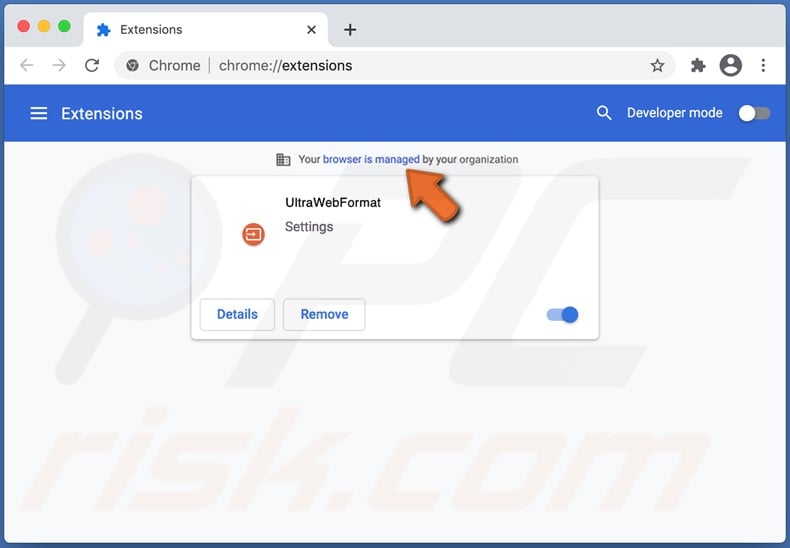
Browser hijackers mainly target popular browsers like Google Chrome, Safari, Mozilla Firefox, and so on. Following successful infiltration, this software assigns fake web searcher addresses as browsers' default search engine, new tab/window, and homepage URLs.
To elaborate on how these alterations affect browsing, with UltraWebFormat installed: new browser tabs/windows opened and search queries typed into the URL bar - redirect to the search.7ax6.com search engine. Illegitimate web searchers are usually unable to provide search results, so they redirect (or cause redirection chains leading) to legitimate search engines.
This applies to search.7ax6.com as well; it redirects to the Google (google.com) search engine. Furthermore, browser hijackers can limit/deny access to the browser settings and/or undo any permitted changes made.
Therefore, restoring an affected browser is impossible without removing the software hijacking it. What is more, most browser hijackers can track data.
Targeted information includes: URLs visited, pages viewed, search queries typed, IP (Internet Protocol) addresses, geolocations, personally identifiable and other vulnerable details. The gathered data is then monetized by being shared with and/or sold to third-parties (potentially, cyber criminals).
To summarize, the presence of data-tracking software on browsers/systems - can lead to severe privacy issues, financial losses, and even identity theft. Therefore, it is strongly advised to immediately remove all suspect applications and browser extensions/plug-ins.
| Name | UltraWebFormat redirect |
| Threat Type | Browser hijacker, Mac malware, Mac virus |
| Promoted URL | search.7ax6.com |
| Serving IP Address (search.7ax6.com) | 99.84.174.76 |
| Symptoms | Your Mac became slower than normal, you see unwanted pop-up ads, you get redirected to shady websites. |
| Distribution methods | Deceptive pop-up ads, free software installers (bundling), fake Flash Player installers, torrent file downloads. |
| Damage | Internet browsing tracking (potential privacy issues), displaying of unwanted ads, redirects to shady websites, loss of private information. |
| Malware Removal (Windows) |
To eliminate possible malware infections, scan your computer with legitimate antivirus software. Our security researchers recommend using Combo Cleaner. Download Combo CleanerTo use full-featured product, you have to purchase a license for Combo Cleaner. 7 days free trial available. Combo Cleaner is owned and operated by RCS LT, the parent company of PCRisk.com. |
Fire Search, Brilliant Check, OriginalSearchManager, and MovieFinder365 are a few examples of browsers hijackers. They typically appear legitimate and useful.
However, their features rarely work as advertised, and in most cases - they do not work at all. This is true of practically all PUAs. The sole goal of unwanted software is to generate revenue at user expense.
Therefore, instead of delivering on any promises, PUAs can cause redirects, hijack browsers, run intrusive advertisement campaigns (adware), and gather private information.
How did UltraWebFormat install on my computer?
PUAs can be downloaded/installed alongside other software. This false marketing method of packing regular programs with unwanted or malicious additions - is termed "bundling".
By rushing through download/installation processes (e.g., skipping steps and sections, using pre-set options, etc.) - users risk unintentionally allowing bundled content into their devices. Intrusive advertisements are also used to proliferate PUAs.
Upon being clicked, intrusive ads can execute scripts to download/install these applications without user permission. PUAs may have "official" promotional/download webpages as well.
How to avoid installation of potentially unwanted applications?
It is highly recommended to research software products before download/installation and/or purchase. Additionally, all downloads must be performed from official and verified sources. Untrustworthy download channels, e.g., unofficial and free file-hosting websites, Peer-to-Peer sharing networks (Torrent clients, eMule, Gnutella, etc.), and other third-party downloaders - often offer dangerous and/or bundled content.
When downloading/installing, it is important to read terms, explore possible options, use the "Custom/Advanced" settings, and opt-out from supplementary apps, tools, functions, etc. Intrusive adverts appear ordinary and harmless; however, they redirect to unreliable and questionable sites (e.g., gambling, pornography, adult-dating, and so on).
Should users experience such ads and/or redirects, they must inspect their devices and immediately remove all suspicious applications and browser extensions/plug-ins. If your computer is already infected with browser hijackers, we recommend running a scan with Combo Cleaner Antivirus for Windows to automatically eliminate them.
UltraWebFormat assigned fake search engine (search.7ax6.com) set as the default in a Google Chrome browser:
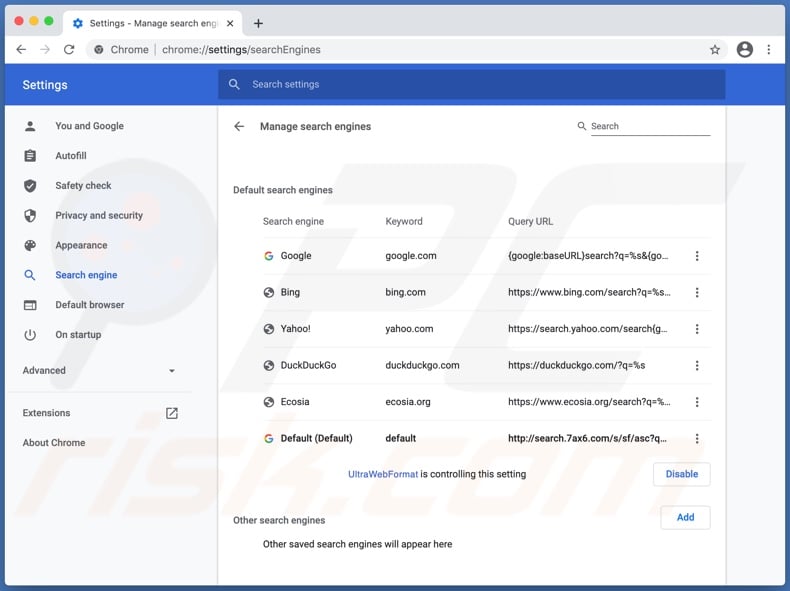
Appearance of search.7ax6.com redirecting to the Google search engine (GIF):
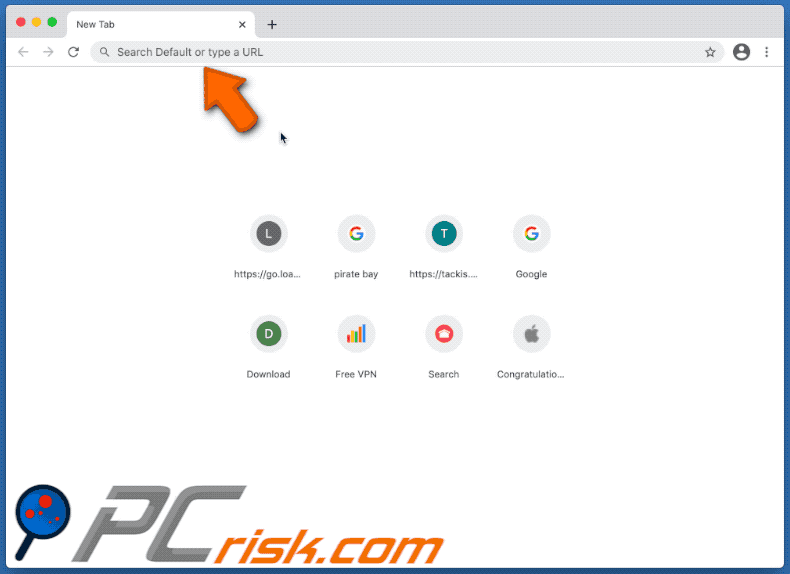
Instant automatic malware removal:
Manual threat removal might be a lengthy and complicated process that requires advanced IT skills. Combo Cleaner is a professional automatic malware removal tool that is recommended to get rid of malware. Download it by clicking the button below:
DOWNLOAD Combo CleanerBy downloading any software listed on this website you agree to our Privacy Policy and Terms of Use. To use full-featured product, you have to purchase a license for Combo Cleaner. 7 days free trial available. Combo Cleaner is owned and operated by RCS LT, the parent company of PCRisk.com.
Quick menu:
- What is UltraWebFormat?
- STEP 1. Remove UltraWebFormat related files and folders from OSX.
- STEP 2. Remove UltraWebFormat redirect from Safari.
- STEP 3. Remove UltraWebFormat browser hijacker from Google Chrome.
- STEP 4. Remove UltraWebFormat homepage and default search engine from Mozilla Firefox.
Video showing how to remove UltraWebFormat adware using Combo Cleaner:
UltraWebFormat redirect removal:
Remove UltraWebFormat related potentially unwanted applications from your "Applications" folder:

Click the Finder icon. In the Finder window, select "Applications". In the applications folder, look for "MPlayerX","NicePlayer", or other suspicious applications and drag them to the Trash. After removing the potentially unwanted application(s) that cause online ads, scan your Mac for any remaining unwanted components.
DOWNLOAD remover for malware infections
Combo Cleaner checks if your computer is infected with malware. To use full-featured product, you have to purchase a license for Combo Cleaner. 7 days free trial available. Combo Cleaner is owned and operated by RCS LT, the parent company of PCRisk.com.
Remove browser hijacker-related files and folders

Click the Finder icon from the menu bar. Choose Go, and click Go to Folder...
 Check for browser hijacker generated files in the /Library/LaunchAgents/ folder:
Check for browser hijacker generated files in the /Library/LaunchAgents/ folder:

In the Go to Folder... bar, type: /Library/LaunchAgents/

In the "LaunchAgents" folder, look for any recently-added suspicious files and move them to the Trash. Examples of files generated by browser hijackers - "installmac.AppRemoval.plist", "myppes.download.plist", "mykotlerino.ltvbit.plist", "kuklorest.update.plist", etc. Browser hijacker commonly installs several files with the exact same string.
 Check for browser hijacker generated files in the ~/Library/Application Support/ folder:
Check for browser hijacker generated files in the ~/Library/Application Support/ folder:

In the Go to Folder... bar, type: ~/Library/Application Support/

In the "Application Support" folder, look for any recently-added suspicious folders. For example, "MplayerX" or "NicePlayer", and move these folders to the Trash.
 Check for browser hijacker generated files in the ~/Library/LaunchAgents/ folder:
Check for browser hijacker generated files in the ~/Library/LaunchAgents/ folder:

In the Go to Folder... bar, type: ~/Library/LaunchAgents/

In the "LaunchAgents" folder, look for any recently-added suspicious files and move them to the Trash. Examples of files generated by browser hijackers - "installmac.AppRemoval.plist", "myppes.download.plist", "mykotlerino.ltvbit.plist", "kuklorest.update.plist", etc. Browser hijacker commonly installs several files with the exact same string.
 Check for browser hijacker generated files in the /Library/LaunchDaemons/ folder:
Check for browser hijacker generated files in the /Library/LaunchDaemons/ folder:

In the "Go to Folder..." bar, type: /Library/LaunchDaemons/

In the "LaunchDaemons" folder, look for recently-added suspicious files. For example "com.aoudad.net-preferences.plist", "com.myppes.net-preferences.plist", "com.kuklorest.net-preferences.plist", "com.avickUpd.plist", etc., and move them to the Trash.
 Scan your Mac with Combo Cleaner:
Scan your Mac with Combo Cleaner:
If you have followed all the steps correctly, your Mac should be clean of infections. To ensure your system is not infected, run a scan with Combo Cleaner Antivirus. Download it HERE. After downloading the file, double click combocleaner.dmg installer. In the opened window, drag and drop the Combo Cleaner icon on top of the Applications icon. Now open your launchpad and click on the Combo Cleaner icon. Wait until Combo Cleaner updates its virus definition database and click the "Start Combo Scan" button.

Combo Cleaner will scan your Mac for malware infections. If the antivirus scan displays "no threats found" - this means that you can continue with the removal guide; otherwise, it's recommended to remove any found infections before continuing.

After removing files and folders generated by the browser hijackers, continue to remove rogue extensions from your Internet browsers.
Remove browser hijackers from Internet browsers
 Remove Safari browser hijackers:
Remove Safari browser hijackers:

Open the Safari browser, from the menu bar, select "Safari" and click "Preferences...".

In the preferences window, select "Extensions" and look for any recently-installed suspicious extensions. When located, click the "Uninstall" button next to it/them. Note that you can safely uninstall all extensions from your Safari browser - none are crucial for regular browser operation.
Change your homepage:
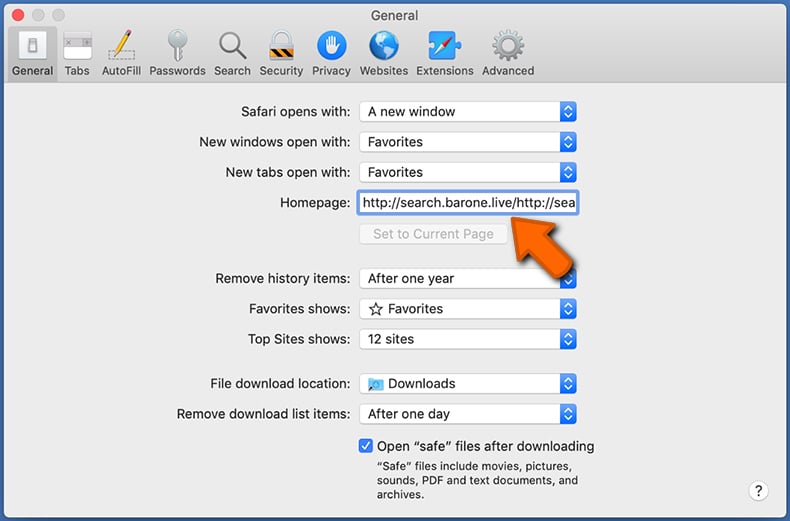
In the "Preferences" window, select the "General" tab. To set your homepage, type the preferred website URL (for example: www.google.com) in the Homepage field. You can also click the "Set to Current Page" button if you wish to set your homepage to the website you are currently visiting.
Change your default search engine:

In the "Preferences" window, select the "Search" tab. Here you will find a drop-down menu labeled "Search engine:" Simply select your preferred search engine from the drop-down list.
- If you continue to have problems with browser redirects and unwanted advertisements - Reset Safari.
 Remove Google Chrome browser hijackers:
Remove Google Chrome browser hijackers:

Click the Chrome menu icon ![]() (at the top right corner of Google Chrome), select "More Tools" and click "Extensions". Locate all recently-installed suspicious extensions, select these entries and click "Remove".
(at the top right corner of Google Chrome), select "More Tools" and click "Extensions". Locate all recently-installed suspicious extensions, select these entries and click "Remove".

Change your homepage
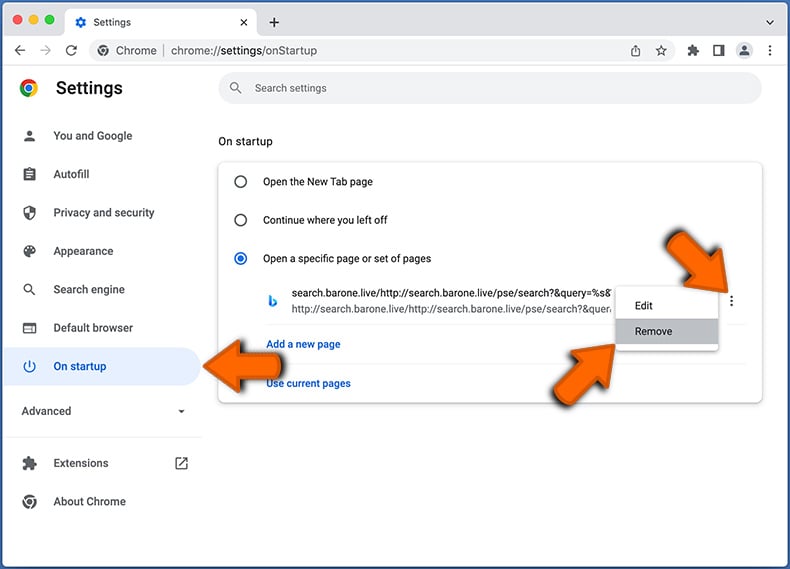
Click the Chrome menu icon ![]() (at the top right corner of Google Chrome) and select "Settings". In the "On startup" section, disable the malicious extension (if present), look for a browser hijacker URL below the "Open a specific or set of pages" option. If present, click on the three vertical dots icon and select "Remove".
(at the top right corner of Google Chrome) and select "Settings". In the "On startup" section, disable the malicious extension (if present), look for a browser hijacker URL below the "Open a specific or set of pages" option. If present, click on the three vertical dots icon and select "Remove".
Change your default search engine:
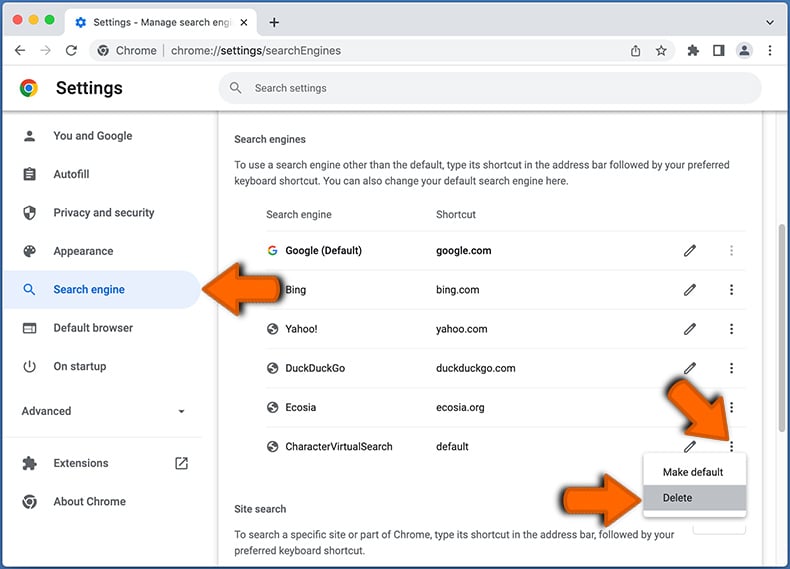
To change your default search engine in Google Chrome: Click the Chrome menu icon ![]() (at the top right corner of Google Chrome), select "Settings", in the "Search engine" section, click "Manage search engines...", in the opened list look for a browser hijacker URL, when located click the three vertical dots near this URL and select "Delete".
(at the top right corner of Google Chrome), select "Settings", in the "Search engine" section, click "Manage search engines...", in the opened list look for a browser hijacker URL, when located click the three vertical dots near this URL and select "Delete".
- If you continue to have problems with browser redirects and unwanted advertisements - Reset Google Chrome.
 Remove malicious extensions from Mozilla Firefox:
Remove malicious extensions from Mozilla Firefox:

Click the Firefox menu ![]() (at the top right corner of the main window) and select "Add-ons and themes". Click "Extensions", in the opened window locate all recently-installed suspicious extensions, click on the three dots and then click "Remove".
(at the top right corner of the main window) and select "Add-ons and themes". Click "Extensions", in the opened window locate all recently-installed suspicious extensions, click on the three dots and then click "Remove".

Change your homepage
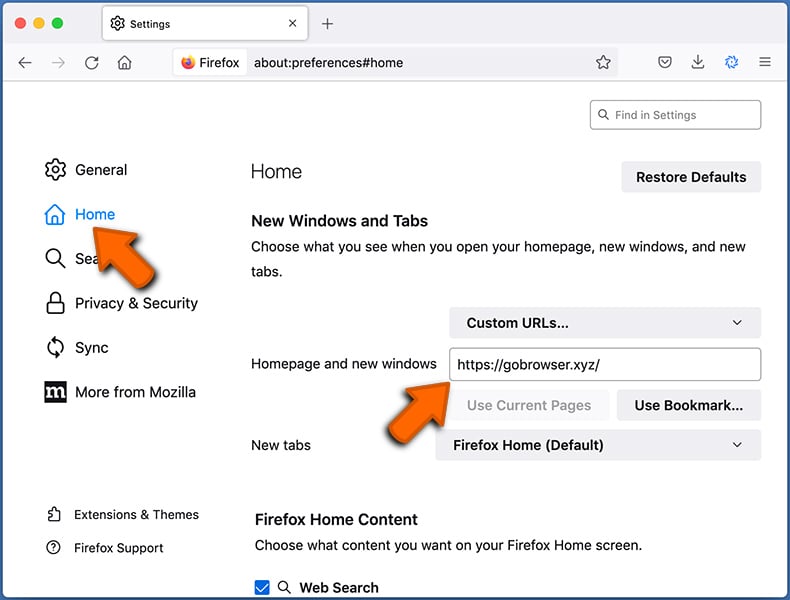
To reset your homepage, click the Firefox menu ![]() (at the top right corner of the main window), then select "Settings", in the opened window disable malicious extension (if present), remove the browser hijacker URL and enter your preferred domain, which will open each time you start Mozilla Firefox.
(at the top right corner of the main window), then select "Settings", in the opened window disable malicious extension (if present), remove the browser hijacker URL and enter your preferred domain, which will open each time you start Mozilla Firefox.
Change your default search engine:
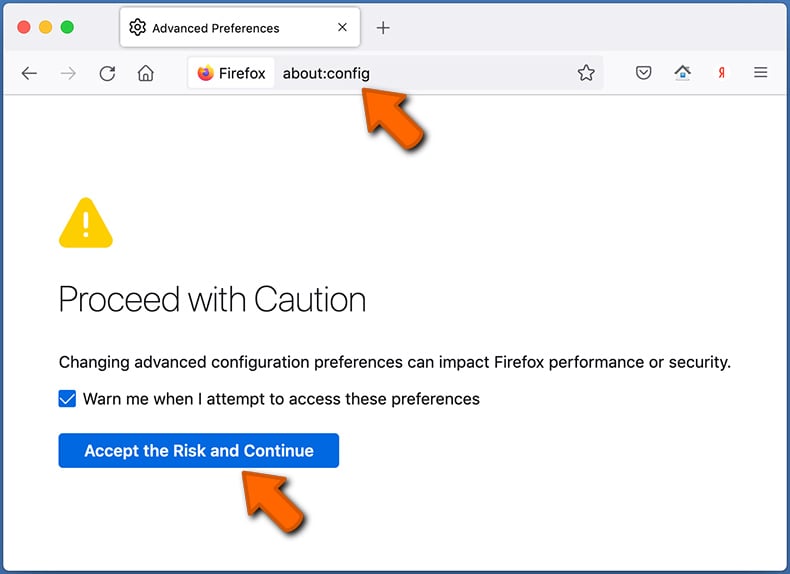
In the URL address bar, type "about:config" and press Enter. Click "Accept the Risk and Continue".
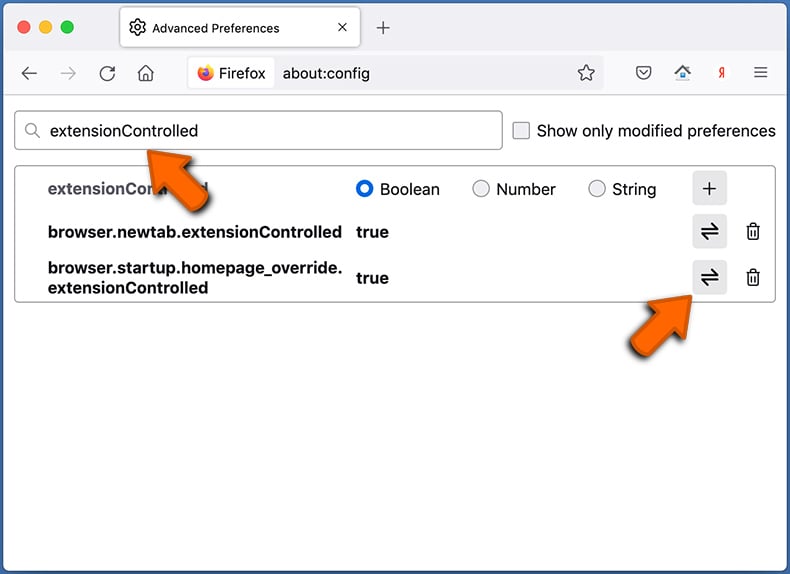
In the search filter at the top, type: "extensionControlled". Set both results to "false" by either double-clicking each entry or clicking the ![]() button.
button.
- If you continue to have problems with browser redirects and unwanted advertisements - Reset Mozilla Firefox.
Share:

Tomas Meskauskas
Expert security researcher, professional malware analyst
I am passionate about computer security and technology. I have an experience of over 10 years working in various companies related to computer technical issue solving and Internet security. I have been working as an author and editor for pcrisk.com since 2010. Follow me on Twitter and LinkedIn to stay informed about the latest online security threats.
PCrisk security portal is brought by a company RCS LT.
Joined forces of security researchers help educate computer users about the latest online security threats. More information about the company RCS LT.
Our malware removal guides are free. However, if you want to support us you can send us a donation.
DonatePCrisk security portal is brought by a company RCS LT.
Joined forces of security researchers help educate computer users about the latest online security threats. More information about the company RCS LT.
Our malware removal guides are free. However, if you want to support us you can send us a donation.
Donate
▼ Show Discussion